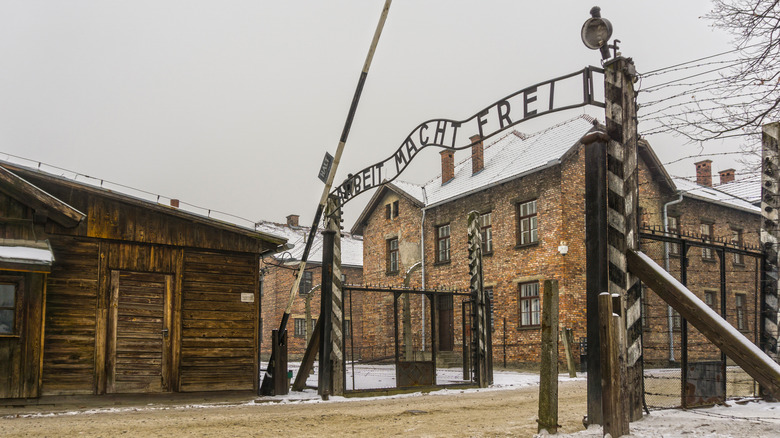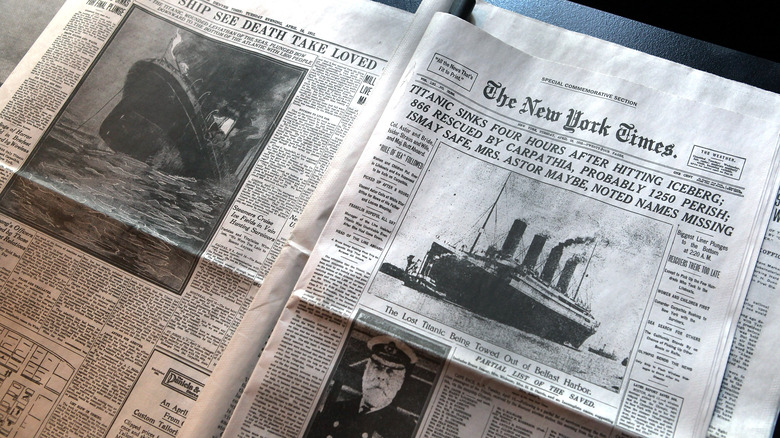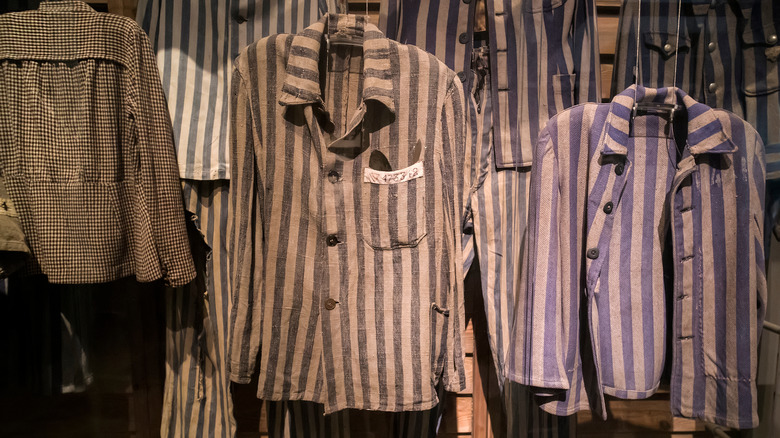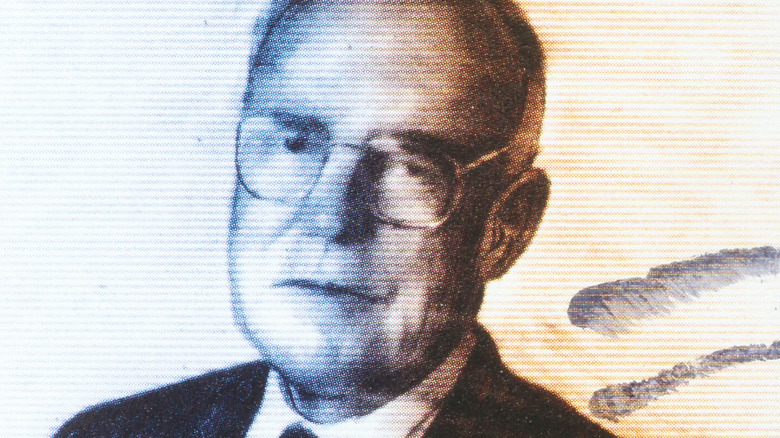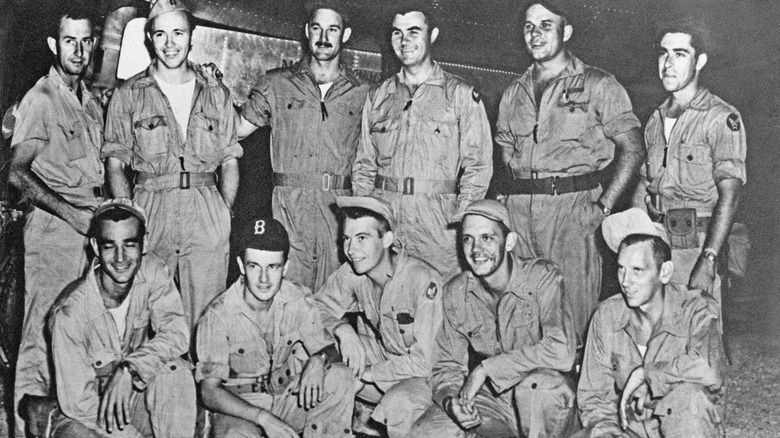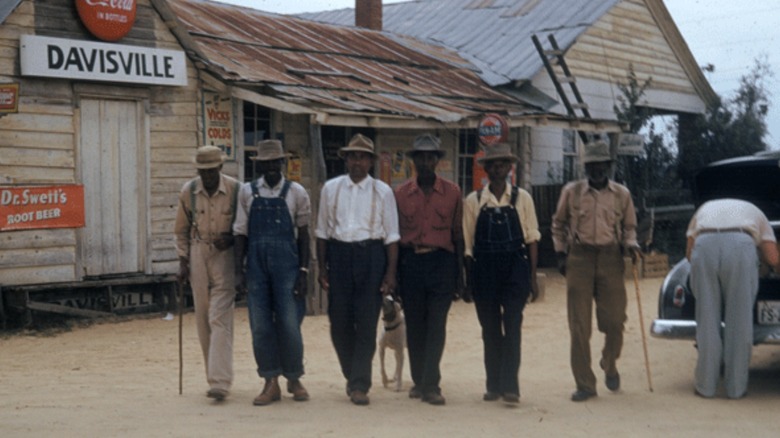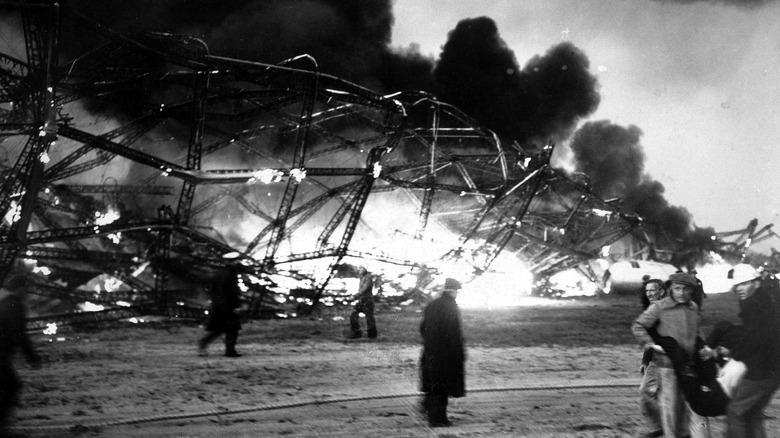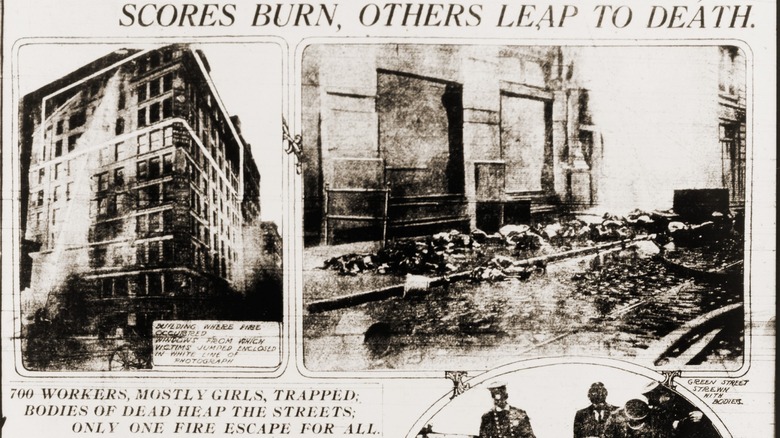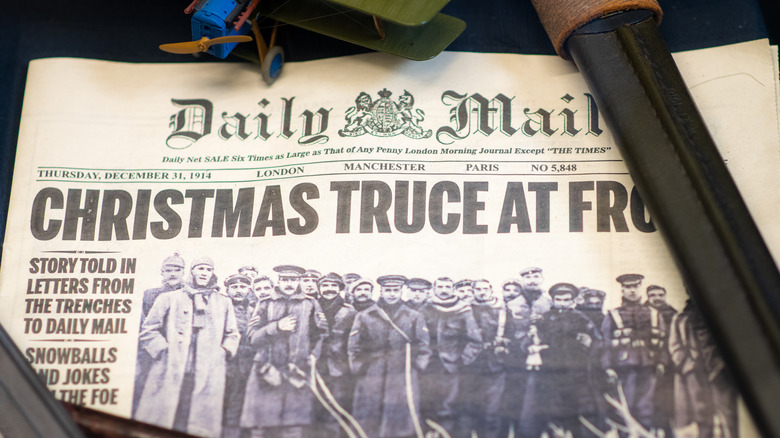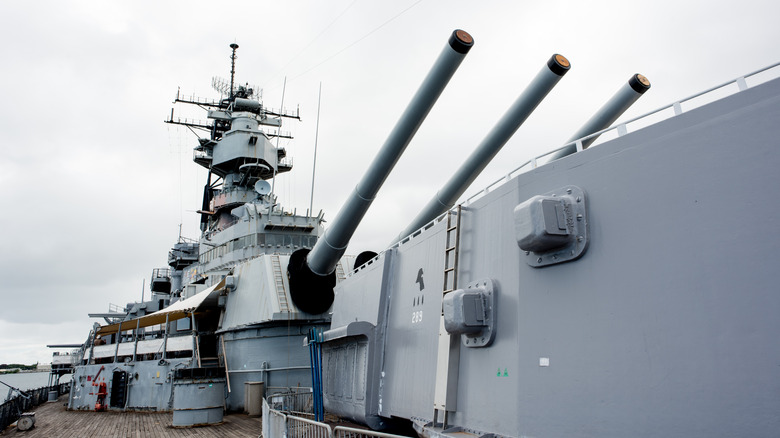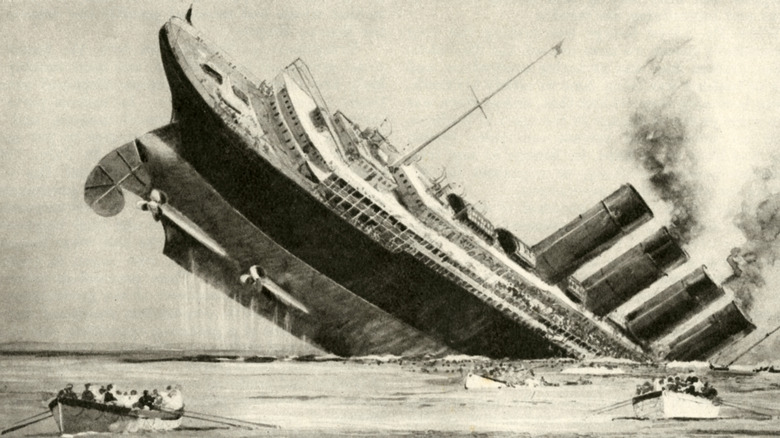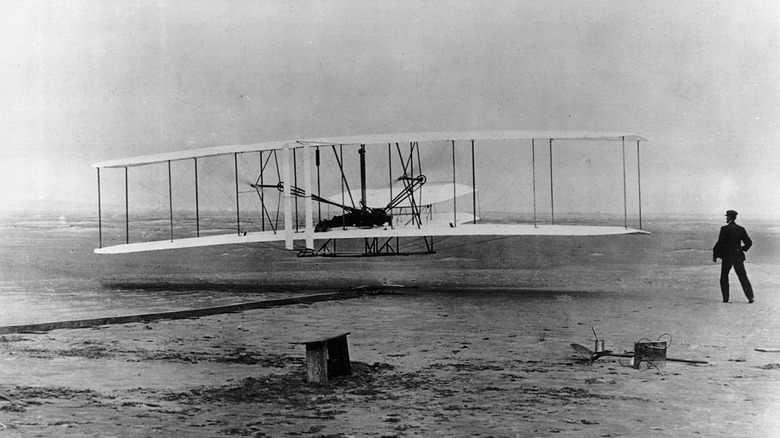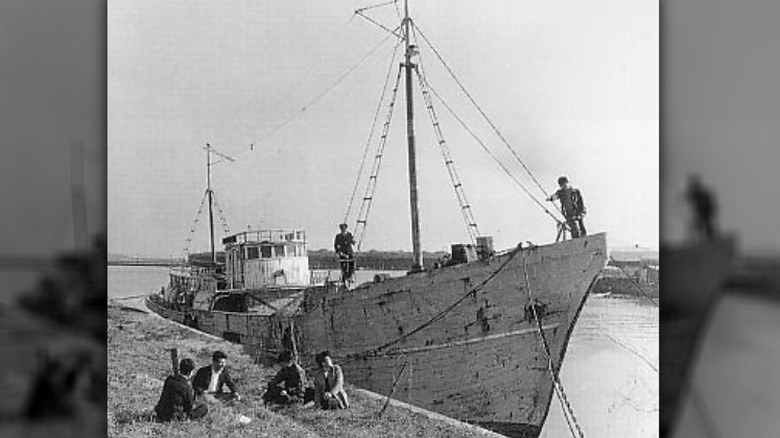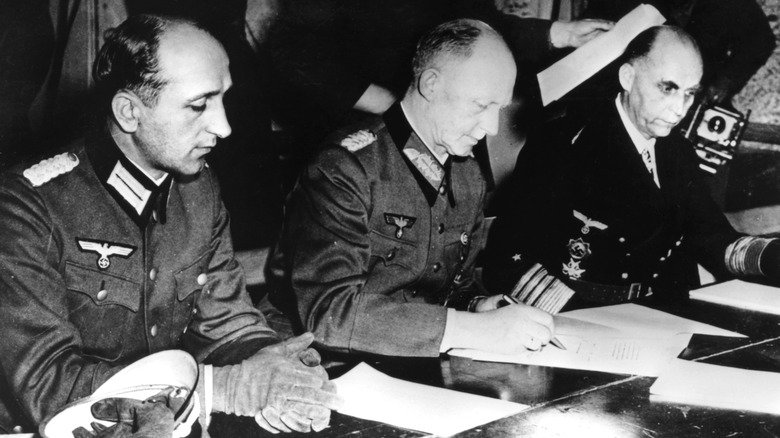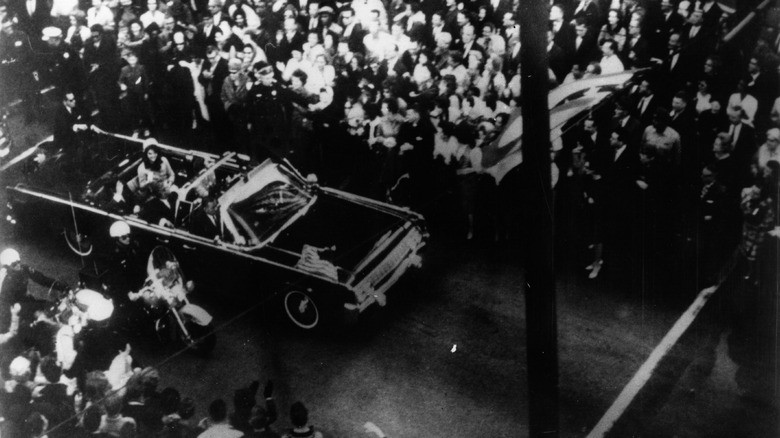These Were The Last Survivors Of Major Historical Events
There's a moment when historical events pass from living memory into the history books, and that's with the death of the last survivor. When that happens, the world loses something: While books can give dates, names, and places, there's a lot they can't give.
The surreal quiet of guns silenced on a Christmas morning, after months of relentless fighting. The stillness of the night after the Titanic disappeared beneath the icy waters. The sounds of the survivors of Auschwitz ... and the smell of the crematoriums. They're all things that words can certainly describe, but not to the extent felt by those who experienced them first-hand.
History is filled with episodes that are horrible, wonderful, awe-inspiring, and world-changing ... sometimes, all at once. There's an old saying that's so true and so often repeated that it's become cliché, and that's the idea that those who don't know their history are doomed to repeat it. That's 100 percent accurate, which is why we all need to take away some very important lessons from these last surviving witnesses.
The Titanic - Millvina Dean
Calling a ship "unsinkable" is just daring the powers that be to prove a boatful of humans wrong, and that's exactly what happened when the Titanic famously sank on April 14, 1912. On board was 2-month-old Millvina Dean, who would become the last surviving passenger.
Dean, her parents, and her brother were emigrating to the U.S. from England. Their final destination was Kansas City, says The Guardian, but they never got there. Although she, her brother, and her mother were among the first passengers who made it into the lifeboats, her father stayed behind and was one of the many who died in the freezing waters.
She became something of a celebrity in her older years, but according to the BBC, she always declined to see any film versions of the sinking — especially James Cameron's version. "It was terrible, I never wanted to see any of those films, and I don't want to see this one," she explained. That wasn't the end of her connection with the movie, though: In 2009 — when she was struggling to pay for her nursing home — the Irish Independent reported that Cameron, Leonardo DiCaprio, and Kate Winslet had all sent a hefty donation to ensure her future.
Dean was 97 years old when she passed away in 2009. She was predeceased by 99-year-old Lillian Asplund — the last remaining American Titanic survivor — who died in 2006, and by Sid Daniels. He was 89 when he died in 1983, and he was the last surviving crew member (via Encyclopedia Titanica).
The liberation of the Auschwitz concentration camp - Ivan Martynushkin
It was David Dushman who drove his tank straight through Auschwitz's electric fence, and according to the Independent, he and his fellow soldiers had no idea what the camp was, and what horrors were about to unfold before them. When he passed away in 2021, that left only a single surviving soldier from that first group to liberate the Nazi's most notorious concentration camp.
Ivan Martynushkin was just 21 years old when he accompanied the Red Army's 322nd Rifle Division into what they first thought was an empty camp ... until they saw some of the 7,000-odd prisoners who had been left behind after the Nazi evacuation. He spoke openly about what they saw there (via CNN): "We saw emaciated, tortured, impoverished people. Those were the people I first encountered ... We could tell from their eyes that they were happy to be saved from this hell. Happy that now they weren't threatened by death in a crematorium. Happy to be freed."
He has said, too, that he had been well aware of the fact that he had been looking at a fate that he could have shared. Around 15,000 of his fellow Soviet soldiers had died at Auschwitz, with hundreds dying in the days just before they got there. And that indiscriminate killing is at the heart of the message he continued to spread, even after he became the last living person to walk into Auschwitz: "the life of entire people were put at stake."
Shockley Semiconductor Laboratory's 'traitorous eight' - Gordon Moore
It probably didn't seem like much of a historic event at the time, but when Gordon Moore and seven of his coworkers at the Shockley Semiconductor Laboratory quit to form their own company, it was the moment that kick-started Silicon Valley and, in turn, laid the groundwork for today's computer age.
Moore became the last survivor of the so-called "traitorous eight" after the 2021 death of Dr. Jay Last, says The New York Times, until his own passing on March 24, 2023. After Last, Moore, and their colleagues parted ways with the notoriously difficult-to-work-with (and notoriously racist) Nobel Prize-winning Dr. William Shockley, they founded Fairchild Semiconductor, developed a method for building silicon chips quickly and efficiently, and the world never looked back. Silicon Valley sprang up around Fairchild Semiconductor, and it's nice to imagine that Shockley was left shaking his fist at them with pure rage.
Moore went on to co-found Intel, and establish the Gordon and Betty Moore Foundation, which gives away $300 million in charitable donations every year. According to Forbes, the charity is worth somewhere around $6 billion, while Moore himself was worth around $8.9 billion. Meanwhile, Moore's Law — the prediction that the processing power of computers was going to double every year — has proved pretty accurate, and it might not have happened if Moore and his colleagues hadn't made the historic decision to quit their jobs and set out on their own.
War of the Worlds - Bill Herz
The days of gathering the family around the radio to listen to a story unfold have been replaced by Netflix and podcasts, but in 1938, one radio drama went down in history. "War of the Worlds" broadcasted across national airwaves in October that year.
NPR says there's quite a bit of debate about whether or not it actually caused any kind of panic with many experts saying that it didn't and that's just a bit of folklore added later. That's impressive in and of itself, and surprisingly, the last member of that broadcast lived to see reports of hysteria and remakes of the story.
Bill Herz died in 2016, according to The New York Times (who, incidentally, described him as "something of a curmudgeon" in an earlier profile piece on him). In addition to working for Orson Welles as a casting director, he played several parts in the radio drama, too: His two ham radio operators talked about the alien invasion they were witnessing were in the final broadcast piece, and during rehearsals, he also stood in for Welles. He wasn't shy about saying just what he thought of the now-famous broadcast, either: "I thought to myself, 'Nobody's going to believe this in a million years.' Boy, was I wrong."
The bombing of Hiroshima - Theodore Van Kirk
In 2014, The New York Times reported on the death of the last man to have a bird's-eye view of the event that would change the course of not just World War II, but warfare. Theodore Van Kirk (standing, second from left) was the navigator on the Enola Gay, and at 93 years old, he was the last survivor of the crew that dropped the atomic bomb on Hiroshima. There was just 43 seconds between the release of the bomb and impact, and Van Kirk recalled: "The plane jumped and made a sound like sheet metal snapping. Shortly after the second wave, we turned to where we could look out and see the cloud, where the city of Hiroshima had been. ... I describe it looking like a pot of black, boiling tar."
He also spoke of the moments immediately following the blast, and the sense that not only had something world-changing just happened, but knowing that their small crew were — for a few short moments — the only ones who knew what had just been done.
The Guardian says that Van Kirk left the military in 1946. After earning a master's in chemical engineering and spending 35 years working for DuPont, he later gave lectures on his role in World War II. He always said that he did it to educate the following generations on what had happened that day, and he always stood by the decision to drop the bombs.
The Tuskegee Syphilis Experiment - Ernest Hendon
There are plenty of historic events that are downright awful, and that includes the Tuskegee Syphilis Experiment. In a nutshell, the study involved 623 Black men who were monitored over the course of four decades. Some were diagnosed with syphilis, some were not, and they were all under the impression they were being treated for other ailments that included things like fatigue and anemia. The Centers for Disease Control and Prevention says the men were not honestly informed of what the study was and consent wasn't given. Worse, even when treatments for syphilis became available, they weren't treated.
The last surviving participant was Ernest Hendon, who passed away in 2004 at the age of 96. According to the Los Angeles Times, Hendon and his brother were both a part of the control group that didn't have syphilis, and he spoke about how they had no idea what they were actually signing up for, just that, "They said it was a study that would do you good."
Hendon outlived scores of other participants: When it went public in 1972, 100 men were dead of complications linked to their participation, 28 were dead from syphilis, and — since they hadn't been told what they had — at least 59 wives and children were also diagnosed with syphilis. Hendon, at least, lived to hear President Bill Clinton's apology: "Everybody knows now that we were mistreated. I'm glad they're seeing now that it will never happen again." At the time, he was one of three survivors.
The Hindenberg - Werner G. Doehner
It was probably unbelievably exciting for an 8-year-old boy: Werner Doehner was going to be one of the passengers of an airship touted as being what the Navy Lakehurst Historical Society described as a "huge flying billboard for German aeronautical supremacy." It came complete with swastikas, had already made 62 perfectly safe and uneventful journeys, and when Doehner and his family boarded in 1937, it was traveling from Frankfurt, Germany all the way to Lakehurst, New Jersey.
That airship was, of course, the Hindenberg, and it was about 175 feet in the air when fire engulfed the airship in around 34 seconds. Doehner's quick-thinking mother pushed both him and his brother out a window before she jumped, and although they spent weeks in the hospital with severe burns, it saved their lives.
Doehner's father and sister weren't as fortunate, and both perished. The last time he saw his father, he had just recorded some video and was heading back to their cabin. His mother had tried to save his sister, too, but had been unable to lift her out of the zeppelin window (via The Washington Post).
The New York Times reported on his death in 2019, saying that the 90-year-old had been the last survivor of the disaster. According to his son, Bernie, he didn't talk about it much: "My dad was secretive about the disaster, and didn't like to talk about it. He was a really private person."
The Triangle Shirtwaist Factory fire - Rose Freedman
It's no secret that, historically, working conditions have been largely pretty terrible. That was brought into sharp relief in 1911, when York City's Triangle Shirtwaist Factory was consumed in a fiery blaze that killed 146 of the 600 factory employees there that day. According to History, this was the fire that put sweatshops and dangerous working conditions in the headlines, particularly because it was determined that most of the deaths should have been prevented — if only basic safety measures had been observed.
Deaths were gruesome: Many were burned alive when they became trapped in stairwells or died trying to jump from the factory's windows. Rose Freedman was one of the lucky ones: The 17-year-old went up instead of down, having found company execs who were fleeing by heading to the roof to be rescued.
She was rescued, too, and went on to become an outspoken campaigner in the fight for employee rights, labor unions, and an overhaul to the nation's worker safety legislation. She also loudly condemned those execs she'd followed to the roof, saying that they'd not only locked the doors because they were afraid of theft but had tried to bribe her to say otherwise. (And as if that's not cool enough, she saved the life of an Austrian spy during WWI.) Freedman was the last survivor of the fire when The New York Times reported on her death in 2001. She was 107 years old.
The Scottsboro Boys' wrongful arrests - Clarence Norris
Clarence Norris was the last surviving defendant in a case that never should have happened and ultimately became a landmark example of racial injustice in America. He was the last surviving member of the so-called Scottsboro Boys, a group of nine young Black men — all between the ages of 13 and 19 — who were accused of raping two white women in Alabama.
The boys had been on the train heading north for work when they were arrested near Scottsboro. The arrest and accusations came in 1931, the case went on until 1937, and even though one of the accusers recanted, Norris received the death penalty three times, and wasn't fully and formally exonerated until 1976.
The New York Times says that he was paroled in 1946, but the stigma was still there — so, he fought it, saying, "A man should never give up hope. ... They had said that I was a nobody, a dog, but I stood up and I said the truth. Somebody's got to do these things in life."
Norris was 76 years old when he died in 1989, and it wasn't until 2013 that three of the men — Haywood Patterson, Charlie Weems, and Andy Wright — received their formal exonerations posthumously (via The National Registry of Exonerations).
The Christmas Truce - Alfred Anderson
It's one of the most famous stories of World War I: the Christmas Truce. It happened on December 25, 1914, when soldiers on opposing sides silenced their weapons and emerged from the trenches. Face-to-face with other soldiers who were just like they were — young men sent into a terrifying war — they traded gifts, sang Christmas carols, and even staged impromptu games of soccer.
According to The New York Times, the last surviving witness to the Christmas truce was Alfred Anderson. He had been 18 years old at the time, and when he died in 2005, he had reached the ripe old age of 109.
He had served with the Black Watch regiment, and spoke of the experience: "All I'd heard for two months in the trenches was the hissing, cracking, and whining of bullets in flight, machine-gun fire, and distant German voices. But there was a dead silence that morning, right across the land, as far as you could see. We shouted 'Merry Christmas!' even though nobody felt merry. The silence ended early in the afternoon, and the killing started again."
The Guardian says that Anderson was also the final survivor of a group of soldiers who took their name from a comment made by Kaiser Wilhelm II: They were the "Old Contemptibles," and he served on the front lines until he was severely wounded in the spring of 1916. He was sent back to England to become an instructor, and he never left the U.K. again.
The diphtheria serum delivery - Edgar Nollner
The famous Iditarod Sled Dog Race covers a 1,100-mile route from Anchorage to Nome, and although it only started in 1973, it was inspired by an event from decades earlier. Then, the relay teams were working against much higher stakes: life and death.
It was 1925, and the highly contagious disease diphtheria had broken out in Nome, Alaska. Life-saving serum was sourced from Anchorage, but it was the middle of the winter, and after getting it part of the way by train, the planes that were going to be used for the final leg of the journey were deemed unflyable. The answer? Man and man's best friend. It took a relay of 20 men and 150 dogs to get the serum there, but they did it — and the last surviving member of that group of fearless men passed away in 1999.
The Los Angeles Times says that Edgar Nollner was the second in the relay team, and at the time he set out, it was already 56 degrees below zero. Still, he and his team covered 24 miles — up the Yukon River — in just around three hours. Other teams suffered catastrophic consequences: Dogs froze and died in their harnesses, and mushers suffered severe frostbite and temporary blindness. The extreme conditions meant there were a series of close calls, but as retold in the movie "Balto," the serum made it in time to save hundreds of lives. Nollner passed away after suffering heart failure at the age of 94.
The Great Train Robbery - Bobby Welch
Train robberies might seem like something that's been left behind in the Old West, but in 1963, a team of 15 men pulled off what the Smithsonian calls the "largest cash theft in international history." It became widely known as the Great Train Robbery, and the thieves not only made off with £2.6 million stolen from a British postal train, but they became international celebrities for basically giving the well-to-do establishment the middle finger at a time when the majority of the world was struggling.
Also, for some context: Adjust that £2.6 million for inflation, and by 2022 that's about £58 million. In U.S. dollars? That's about $70.7 million at the time of this writing.
The entire thing was orchestrated with help from a still unidentified inside man known only as The Ulsterman, and the 15 thieves went their separate ways. Some fled the country, some were arrested, one was killed by a hitman, and the last survivor is Bobby Welch. As of 2019, he was reportedly still alive. He was released from his 30-year jail sentence on June 14, 1976, and according to I News, he absolutely found the person who had been in charge of his share of the cash during his jail time. The Guardian says that the deaths of all the other robbers mean it's unlikely that the mysteries surrounding the robbery will ever be solved.
Japan's WWII surrender - Robert Kenneth Kaufman
It's no secret that World War II was full of unspeakable horrors, and that was definitely true of combat in the Pacific. Japan, says The National WWII Museum, was still in doubt as to whether or not they wanted to bring the war to an end all the way up until the documents were signed. That happened in a September 2, 1945 ceremony on board the USS Missouri, when U.S. General Douglas MacArthur accepted Japan's surrender (via the U.S. Department of Energy).
The deck of the ship was lined with people, and the very last surviving American to witness the monumental signing passed away in 2019. At the time of the surrender, he was Lieutenant Commander Robert Kenneth Kaufman, and he served at the ceremony as an Aide and Flag Lieutenant, according to his obituary from the United States Naval Academy's Alumni Association and Foundation. Kaufman would go on to earn the rank of captain, and by the time he was front and center for the surrender, he had already served in the North Atlantic, North Africa, and had taken part in Operation Torch.
After his retirement, he continued to participate in remembrance events: The U.S. Navy Memorial reports that when he laid the wreath at the 2017 Pearl Harbor Remembrance Day, he was already the sole survivor of the witnesses of Japan's surrender.
The sinking of the Lusitania - Audrey Lawson-Johnston
If there were any Americans that were still on the fence about getting involved in World War I, they almost certainly had a change of heart on May 7, 1915. That's the day a German U-boat targeted and sank the passenger liner the Lusitania, killing 1,198 of the 2,000 people on board — including more than 100 Americans.
The last known survivor was Audrey Lawson-Johnston, who passed away in 2011 at the age of 95. According to the Independent, she had been just 3 months old when she was on board the doomed passenger liner, and owed her life to the nursemaid who was traveling with the family. It was 18-year-old Alice Lines who made sure she and her brother made it to a lifeboat. It wasn't easy: Lines would later testify (via The Lusitania Resource) that she had initially been pushed away from the lifeboats, but jumped in the water to follow her young charges.
Lines and the two children were soon reunited with parents Warren and Amy Pearl, but tragically, their two other daughters and their nurse were lost in the disaster, and their bodies never recovered. Lawson-Johnston made her thoughts on the sinking clear: "I never blamed the sea, because it wasn't the sea's fault. It was the Germans' fault and that was that."
The Wright brothers' first flight - Johnny Moore
Johnny Moore was just 16 when he became an accidental witness to one of the biggest historical events in transportation history. Moore just happened to be walking on a beach in Nags Head, North Carolina, when he saw something potentially interesting going on nearby. When he walked over, he found a small group tinkering with a massive machine. Two of the men were Orville and Wilbur Wright, and the machine was their plane that was just about to take off and make that first historic flight.
It was Moore that first announced the flight to the world — or, what part of the world heard him shouting as he ran down the rest of the beach on that December day in 1903. It was also Moore that helped pinpoint the location for a later monument, and although Wright Stories says that he lived long enough to be the last surviving witness to that historic first flight, his story is a sad one.
The 66-year-old Moore committed suicide in February of 1952. His body was found in his home, which was just a short distance from the Wright Brothers' monument.
The Daigo Fukuryu Maru tragedy - Matashichi Oishi
The Bulletin of the Atomic Scientists says that while scores of people visit the memorials to the World War II bombings of Hiroshima and Nagasaki, there aren't nearly as many who visit the 94-foot fishing boat that is the Daigo Fukuryu Maru. That may be because they may not realize what happened to the boat and the 23-member crew was so terrible that it — not the aforementioned Hiroshima and Nagasaki bombings — kicked off a worldwide movement to ban atomic weapons.
It was March 1, 1954, when the little fishing boat was caught in the fallout from the U.S.'s Castle Bravo tests of a new thermonuclear device. The boat was 86 miles away from the test site but was still caught in the ash rains that fell afterward and lasted for five hours. All the men on the ship were hospitalized, all suffering from bloody sores and blisters, hair loss, and damage that would haunt them for the rest of their lives.
The last survivor of the ill-fated Lucky Dragon was Matashichi Oishi, who passed away in 2021 — 67 years after he was caught in Castle Bravo's fallout. Arab News Japan says that Oishi — who wrote a book about his experience — struggled with health problems his entire life. He was diagnosed with liver cancer, sleeping sickness, and hepatitis C: Although he always knew what the cause was, he fought for five decades to be given status as a victim of a nuclear bomb. He also blamed the lasting health problems for the stillborn death of his child.
Germany's first WWII surrender - Luciano Louis C. Graziano
Technically, World War II came to an end several times, and Germany alone actually surrendered twice — National Geographic says that the first happened on May 7, 1945, and a second time on May 9. The first was signed in Reims, France, and the second — done at the behest of Stalin and the Soviets — happened in Berlin. Let's talk about the first, as that was the one attended by then-22-year-old Luciano "Louis" C. Graziano, who became the last surviving witness.
He told The Buffalo News that at the time, he didn't really even think about what a big deal it was: "I just did what I had to do." Later, the distance brought with time made him realize just how significant it was. "I was honored to be in that room," he would later write.
Drafted out of his sister's beauty parlor in East Aurora, New York — where he did everything from haircuts to perms — he was assigned to a unit tasked with keeping Allied buildings up and running. After hitting Omaha Beach in the third wave, he participated in the Battle of the Bulge, and was serving as utilities foreman when he was asked to oversee the outfitting of the Little Red School House for surrender.
After the war, he opened his own salon in Georgia. His daughters oversee the business now, and he has since written a book — "A Patriot's Memoirs of World War II — Through My Eyes, Heart, and Soul" — about his experiences in the war.
John F. Kennedy's assassination - Clint Hill
There were a lot of people in the crowds lining the streets of Dallas on that day that President John F. Kennedy was assassinated, but as far as those that had a front row seat? Town and Country reported that of those who were in the limo that day, Secret Service agent Clint Hill is the last survivor.
Hill is clearly featured in all the footage: He was the one on the back of the limo, who jumped in the back seat to shield the president and first lady from any more bullets. CNN says that Hill avoided interviews and speaking publicly about the assassination for decades before sharing his own recollections of what he saw first-hand, particularly when he was in the back of the limo with the president and first lady.
"I felt there was something I should have been able to do. Moved faster, reacted quicker, gotten there just moments quicker, could have made all the difference in the world," he recalled, after saying that the years following Kennedy's death were, for him, filled with nightmares, alcohol, and isolation. "You just have to accept it and live with it, the best you can."
Hill served alongside five presidents — Eisenhower, Kennedy, Johnson, Nixon, and Ford — and after his retirement in 1975, he went on to write several books about his service. One specifically focuses on Jackie Kennedy, who he continued to protect after the death of her husband.
